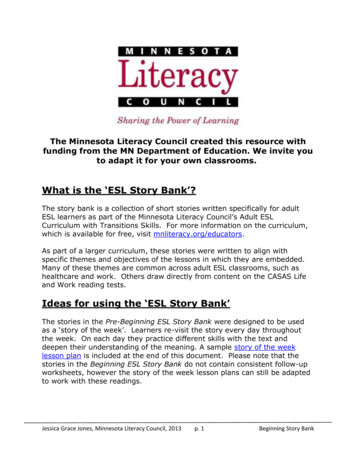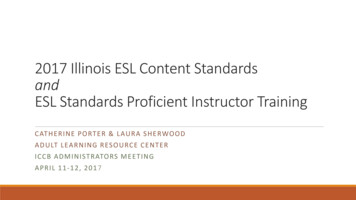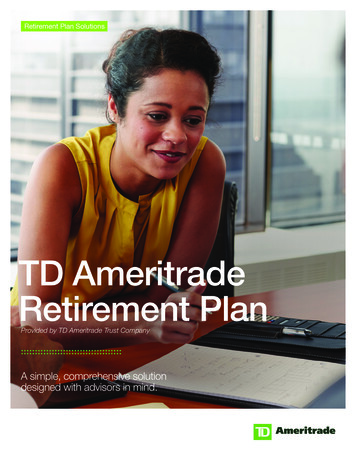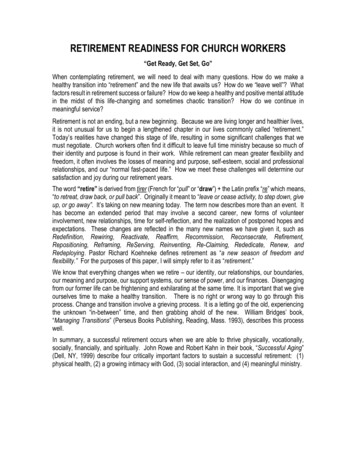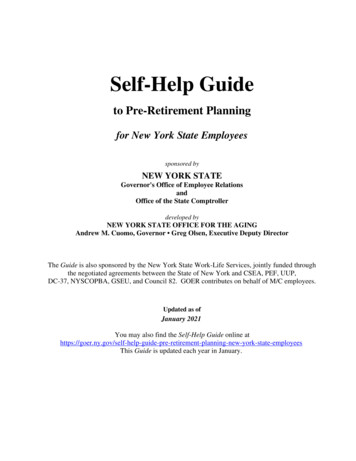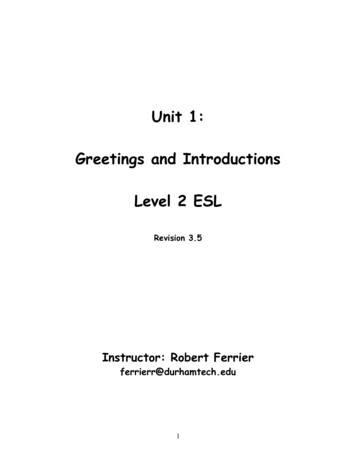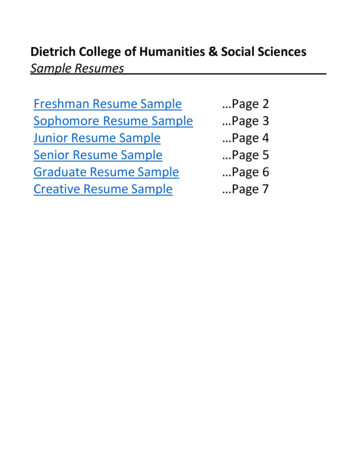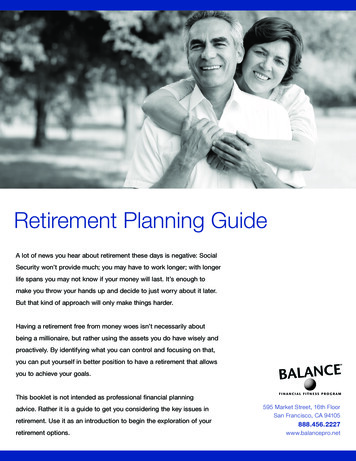
Transcription
Retirement Planning GuideA lot of news you hear about retirement these days is negative: SocialSecurity won’t provide much; you may have to work longer; with longerlife spans you may not know if your money will last. It’s enough tomake you throw your hands up and decide to just worry about it later.But that kind of approach will only make things harder.Having a retirement free from money woes isn’t necessarily aboutbeing a millionaire, but rather using the assets you do have wisely andproactively. By identifying what you can control and focusing on that,you can put yourself in better position to have a retirement that allowsyou to achieve your goals.This booklet is not intended as professional financial planningadvice. Rather it is a guide to get you considering the key issues inretirement. Use it as an introduction to begin the exploration of yourretirement options.595 Market Street, 16th FloorSan Francisco, CA 94105888.456.2227www.balancepro.net
Retirement GoalsHarness the Power of TimeWhen working on retirement planning, it’s importantto think about what your retirement will look like. Willyou be content to focus on occasionally playing golfand spending quality time with family and friends? Ordoes your ideal retirement involve lots of foreign traveland dining out at fancy restaurants? When beginningto think about what your financial needs will be inretirement, it can help to write down five goals youwould like to accomplish in your golden years. Thesedon’t have to be monumental achievements, justwhat will make you happy. For example one of yourgoals may simply be to fully relax after decades ofhard work. But by starting to think about these typesof things, you can begin to build a plan for yourretirement around those goals.The chart below reflects a savings plan of 2,000 a year atnine percent interest. 200,000 150,000 100,000 50,000 015 yearsStart nowHow Much Will You Need?25 years30 yearsWait 10 yearsKnowing you will have enough on a monthly basis tolive comfortably is great, but how do you know if itwill last? After all, you don’t know how long you mightlive, especially with increasing life spans resulting inretirements of 30 or even 40 years. If you are worriedabout stretching your dollars over the full length ofyour retirement, consider meeting with a financialplanner and taking one or more of the followingsteps:The traditional rule of thumb with retirement was thatyou will need 70-80% of your income in retirement tobe able to live a comfortable life. However, everyone’ssituation is different: some people find that theyactually spend more money in retirement than theydid the last few previous years and others findthey are perfectly content to live their mature yearsmodestly with simple pleasures. Complete a budget and stick to it both now and inretirementCompleting a retirement budget is a far morecomprehensive way to examine your money needsthan simply relying on a percentage of your currentexpenses. While it can be difficult to project yourlifestyle into the future – especially if you are currentlymany years away from leaving the workforce – beginby using your current budget as a jumping off point.Think about expenses that may be less in retirement- like clothing or gas – and expenses that could bemore - like airline tickets or healthcare expenses. Ofcourse, remember to calculate inflation, especially ifyou are more than a year ortwo from retirement.The financial calculators atwww.balancepro.net can helpyou crunch the numbers. Ifyou are close to retirement andwant to see if your budget isrealistic, give it a test run for amonth.20 years Make conservative withdrawals from retirementplans Work longer and delay taking Social Security toincrease the amount you get each month Work part-time in retirement Consider an annuity Use assets – such as a home – as a source ofincome Explore longevity insuranceThe financialcalculators atwww.balancepro.netcan help you crunchthe numbers. Invest in financial products that generate dividends Invest in bonds as security against dwindlingincome2
Retirement Incomecontributions as a part of your monthly expenses isa very strong plan for giving yourself fewer worries inyour later years. Making contributions every monthallows you to harness the power of time and usecompound interest to really see your investmentgrow substantially. Someone who is 40 yearsfrom retirement and is putting 100 a month into aretirement fund and seeing normal returns could endup with around 320,000 dollars in that account bythe time they retire.If you are currently among the gainfully employed,you are used to receiving a regular paycheck eachmonth. In retirement this may be different, since youcould have several sources of income making upyour monthly “paycheck.” To see what your currentretirement paycheck looks like, consider all potentialsources of income:SourceContactSocial Securitywww.socialsecurity.govRetirement accounts(401k, 403b, IRA)Plan administratorPensionEmployerInvestmentsAccount administratorPart-time workEstimate based on current wagesHome equity loan orreverse mortgageEstimate home value or equitypositionAssets that can beliquidatedAdjust current figures for inflationCash value insurancepoliciesPlan administratorAnnuitiesAccount administratorInterest on savings, CDsor bondsConsult with provider and usefinancial calculatorIncome from rentalpropertiesAdjust current figures for inflationInheritanceConsult with benefactorCompleting a budget is alsogreat exercise in identifyingretirement drainers like highamounts of unsecured debtor a lack of savings. SomeCompleting aof your debts can add value,budget is alsolike a mortgage or studentgreat exerciseloans. However, debts thatin identifyingaren’t producing benefits forretirement drainersyou, like perhaps credit cardlike high amounts ofdebt or personal loans, canunsecured debt or abe thought of as a negativelack of savings.investment in your future.You may be seeing greatreturns on your retirement investments, but becauseof your unproductive debts, the net total is that youare actually losing money. As a part of the budgetingprocess, examine how much of your money eachmonth is going toward paying on debts that aren’tbringing you a return. While it is important to alwaysbe putting some money toward retirement, it maymake sense to dedicate a portion of that money inyour budget to first paying off expensive debts.Add your monthly expected retirement totals fromall these potential sources of income to see howyour income projection currently sizes up. If this fallsshort of what you had projected in your retirementbudget, look for ways to increase the amount youare currently putting toward retirement or ways togenerate extra income during retirement.Another enemy of retirement is insufficientemergency savings. Retirement accounts aren’tmeant as a safety stashes of cash you can accesswhen unexpected expenses arise, but unfortunatelymany people use them that way. Rather thansacrificing your retirement money the next time thecar breaks down or the furnace stops working, tryto build up 3-6 months of your monthly expensesin an emergency savings account to help protectthe money set aside for your golden years. Thismay mean making a few temporary sacrifices inthe discretionary spending in your budget, but thedecrease in stress down the road will be worth it.Creating a Retirement-empowering BudgetDoing a budget isn’t just about making sure you haveenough money to cover your bills month-to-month.It’s also about having a plan in place to achieve yourlife goals. As you complete a budget for your currentfinancial situation, think about your future as a billthat needs to be paid every month. Whether it is 25a month or 500 a month, maximizing your retirement3
Maximize matching contributionsYou don’t have many chances in life to get freemoney. But a lot employers offer just that whenthey agree to make matching contributions to yourretirement savings. Usually these funds are givendollar-for-dollar to a certain amount, or providedas a percentage of your contribution each month.If your employer offers matching contributions, doeverything in your power to try to get as much of thisfree money as possible.DiversifyWhen choosing how to allocate your money amongdifferent types of investments, it’s important tonot put too much of your funds into one type. Byspreading your investments among different types ofproducts – stocks, bonds, cash equivalents, etc. –you give yourself protection against major losses byone type of asset class while also providing yourselfexposure to potential gains in different areas.Understanding the Retirement FundamentalsStart earlyTime is one of the biggest advantages you can havein saving for retirement. Unless your retirement is nextmonth, you have the opportunity to take advantage ofcompound interest. Because the interest you receivefrom investments or savings is calculated on yourrunning total of deposits plus your past accumulatedinterest, you have a chance to see even a relativelysmall amount of money set aside each month addup to a large bundle when you choose to retire.Someone who is 30 yearsaway from retirement couldput 100 per month into aretirement account, receivea fairly typical 9% return ontheir investment, and endup with close to 180,000for retirement. If that sameTime is one of theperson waits 10 years tobiggest advantagesbegin investing for retirement,you can have inthe total saved would only besaving for retirement.around 67,000.Grow and protectIn deciding what types of specific investments yourretirement funds will go toward, it’s important tothink about both risk and reward. Some types ofinvestment products, like stocks for example, comewith a higher risk of large fluctuations but in turn giveyou a greater chance for growth. Others are moreconservative choices that have little chance for hugegrowth but are much less likely to vary widely. Aprudent retirement investor has a mix in their portfolioof both growth and security.RebalanceIf one category of your investments realizes gainsdisproportionate to the other types of investmentsin your portfolio, your allocations could get out ofbalance. For example, if the stocks in your portfoliosee tremendous growth while the bonds lag behind,the value of your stocks could grow beyond theoriginal percentage of your portfolio they wereintended to represent. This is when it is necessary tocontact your retirement plan provider to return eachpiece of the asset pie back to its original relative size.This process is called rebalancing.Use tax-deferred growthSo-called defined contribution plans provided byemployers, such as 401(k) or 403(b) plans, allowyour retirement savings to be free from taxes whilethey grow in value. Your investment will only betaxed when you withdraw money from the account.A defined contribution plan also has the benefit ofreducing taxable income when you file your returnevery year. Individual Retirement Accounts (IRAs)also can provide tax benefits. See descriptions of thedifferent plans below for more information.While there is no set consensus on how often youshould rebalance your portfolio, the most commonsuggestions from experts vary from once per quarterto once per year. Other experts advise to rebalanceany time your allocations have swung five percent inany direction. Many retirement funds automaticallyrebalance your allocations for you, so check with your4
fund’s administrator for more information. If you needto manually rebalance your settings, make sure youare aware of any fees charged for making these kindsof changes.Dollar cost averagingIf you have a significant amount of money investedin stocks, you likely keep a pretty close eye on whatthe market is doing. When it goes up, you probablyhave a positive feeling about continuing to contributemoney to equity investments. However, when stocksgo down, it can make you want to pull your moneyout quickly. If these emotions get the better of you,the net effect is that you consistently buy stockswhen they are relatively high-priced and then abstainfrom buying them when they are priced lower. Usingthis method will mean that the average price of thestocks you have bought will always be higher.your employer allows you to control the investmentchoices for your plan, you can decide which mixof different types of investments you want yourparticular plan to put money into.There is a way to combatthis emotional “chasing themarket” type of trading,though. Dollar cost averagingmeans that when beginningan investment strategy, you.take a “biggerdecide on a period of timepicture” approachfor which you will commit ato your investing.consistent amount of moneyto be invested at regularintervals. Using dollar cost averaging is a way to takea “bigger picture” approach to your investing that canin the end give you much better value for the moneyyou have invested and help you avoid the pitfalls ofreactionary investment choices.Traditional IRAThis type of Individual Retirement Account lets youinvest pre-tax income that will also grow tax-deferred.Depending on your income, filing status and otherfactors, you may be able to deduct your contributionsto a Traditional IRA on your tax return. Like a definedcontribution plan, there are limits on what you areable to contribute. If you are 50 or older, you maybe allowed to make catch-up contributions beyondthe normal limits. You are able to make any type ofinvestment you like, as long as it is allowed by thecustodian (usually a financial institution or brokerage)of the account. Generally speaking there are norequirements for making contributions to a TraditionalIRA, but any distributions taken before age 59.5are subject to taxes and a 10% penalty, unless thedistribution meets certain conditions.Types of Retirement Savings PlansYou have several different choices for how to investyour money for retirement. You don’t have to pickjust one, and in fact, many people use a combinationof different types of plans to achieve their retirementsavings goals.Roth IRAUnlike a Traditional IRA, under which yourcontributions are taxed upon withdrawal, in a RothIRA your contributions are taxed. Withdrawals canthus be taken tax-free. Like a Traditional IRA, thegains made by your investments are not taxed. Manypeople who feel they may be in higher tax bracketwhen they retire than they are now find that a RothIRA is a good fit for their needs. In order to contributeto a Roth IRA, you or your spouse must have earnedincome. Direct contributions to a Roth IRA can bewithdrawn tax-free at any time.401(k) or 403(b)These retirement plans allow you to take advantageof tax-deferred growth since neither contributionsnor growth are taxed. Taxes aren’t taken until youwithdraw money from the account. Many employersalso provide matching contributions that areessentially free money added to your retirementaccount. There are restrictions on contributionamounts and penalties for early withdrawals. If5
AnnuityAnnuities are issued by insurance companies and aredesigned to grow in value and then pay out a streamof guaranteed monthly payments in retirement. Theyare usually considered an option after 401(k) orIRA options have reached maximum contributions.Drawbacks can include the high fees and lack offlexibility often associated with annuities.Brokerage accountWhile investment accounts opened with brokeragescan give you greater flexibility with accessing yourmoney and making investment choices, they lack thetax advantages of other retirement savings optionsand thus are usually not a top choice for this type ofsavings goal.Self-employed PlansAsset AllocationIf you are your own boss planning for retirementmay take a little extra work, but there are some verybeneficial options for you too. Below are a few of themost popular choices. (For specific questions aboutany of these options, contact your employer or afinancial planner.)Once you have decided what type of plan you willuse to harbor your retirement nest egg, it’s time tochoose what types of investments will make up yourplan.Individual 401(k)As the name implies, the Individual 401(k) –sometimes called the Solo 401(k) – is similar to theretirement plan offered by employers. However,this plan is only for sole proprietors who have noemployees. Like IRAs, the Individual 401(k) comeswith Traditional or Roth options. This plan also hasthe benefit of allowing you to borrow money againstyour savings.When choosing where you will invest your money,it is important to think about the time window youhave until retirement. If you have more than 20 yearsuntil retirement, it is essential that your portfolio havethe ability to grow significantly in that time. For thatreason, you should be willing to take on some risk ofperiodic fluctuations in exchange for the long-termgrowth of your money. If you have a shorter timehorizon, say 5 years until retirement, you need to havea greater level of security in your investments to makesure you don’t get caught ina major downswing in yourinvestments just as you areabout to retire. Most peopledo a mix of stocks, bonds,cash equivalents and otherchoices to give themselvesWhen choosingdiversity and exposure towhere you willgrowth opportunities.invest your money,SEP IRAA Simplified Employee Pension, or SEP IRA, is a wayfor business owners to receive the same advantagesfor their business that would ordinarily be providedthrough a Individual Retirement Account. If thebusiness owner has employees, the employeesreceive the same benefits as the owner under theplan. The employer receives a tax deduction for plancontributions.SIMPLE IRAA Savings Incentive Match Plan for Employees,called a SIMPLE IRA for short, requires businessesowners to contribute once it is opened but isdiscretionary for any employees. This plan requirescertain contributions by the employer on behalf of theemployees.Below are some popularinvestment choices that canhelp you build a retirementinvestment plan with bothgrowth and protection.6it is importantto think aboutthe time windowyou have untilretirement.
words, when you are ready to start taking out yourmoney, the value of your account hasn’t grown asmuch as the cost of the common goods and servicesyou will need to spend that money on. However, sincemany cash equivalent investments are insured by thegovernment and losses are rare, this asset class canbe a good choice when you are looking to preservemoney in the months leading up to your retirementdate.Mutual fundsIf you’re like most people andwant to protect your retirementmoney by diversifying yourinvestments, a mutual fundcould be a solid choice foryour needs. Since mutualfunds are designed to spreadyour money among differenttypes of investments, youautomatically get exposure tovarying types of products. Thisvariety can be within an assetclass or across assets classes.StocksStocks, sometimes also called equities, give you anownership interest in a company. For this reason,there has traditionally been great potential for growthwith stocks as the economy grows and companiesflourish over time. The trade-off with investing instocks is that there is a greater likelihood of dramaticswings in value in the short-term. However, the bestargument for investing in stocks is that they havehistorically far out-paced inflation in any large periodof time. For this reason, stocks should always be onyour retirement savings menu.If you’re like mostpeople and wantto protect yourretirement moneyby diversifyingyour investments,a mutual fundcould be a solidchoice for yourneeds.For example, you canchoose a stock mutual fundthat will invest in differenttypes of companies, such as energy, technology,pharmaceutical, mining, etc. Or you can choose amutual fund that divides your monthly investmentamong stocks, bonds, cash equivalents and otherasset classes. The money you put into a mutual fund,which is pooled with other investors, is managed by aprofessional as a single investment product. You canrequest a prospectus to see how a particular mutualfund has performed in the past.BondsWhen you invest in bonds you are lending moneyeither to a company or to the government. Inexchange for this loan, you get interest paid to you atpredetermined times and amounts. This offers moresafety than stocks, which can vary greatly in value.But the downside here is the lack of growth potential.Bonds are often thought of as a way to temperthe effect of tempestuous investments. Generallyspeaking, bonds are another standard choice forretirement savings because of their nearly guaranteedreturns.Now that you know some of the popular optionsfor retirement investments, how do you know howto make your allocation choices? Usually the mostimportant factor is your retirement time frame. If youare decades away from retirement, you have timeto ride out the ups and down of the stock marketin exchange for the likely continued growth in stockinvestments. You might consider an aggressive mixof investments such as 75% in stocks, 15% in bondsand 10% in cash equivalents. Once you get closer toretirement, a conservative blend of 25% stocks, 25%in bonds and 50% in cash equivalents could bettersuit your desire for protection.Cash and cash equivalentsCertificates of Deposit (CDs), money market funds,money market funds or treasury bills tend to beamong the safest investments you can make but alsogenerally offer the lowest returns. Since the returnsare so modest, there is a risk that your investmentdoesn’t grow as much as the rate of inflation. In other7
latter two haven’t been doing so well, while the valueof your stock investments has gained significantlysuch that now, stocks actually make up a total of80% of the money you have invested. This doesn’tmatch with your current allocation plan since youwanted to have 70% of your investments in stocks.Rebalancing your account would require you to movesome of your gains in stocks into your bond and cashequivalent allocations to “rebalance” your investmentchoices. While you can do this on your own, you willlikely find it much easier to use a plan that does thisautomatically.If you have a set amount of money that you put intoa retirement plan each month and you don’t tinkerwith your allocations, you are using dollar costaveraging. As mentioned above, dollar cost averagingmeans that you invest the same amount of moneyeach month in a particular asset class no matter thecurrent value of those investments. For example, ifyou are putting 100 per month into stocks, you putthat same amount into stock in the same companiesregardless of whether the prices of those stockshas risen or fallen. In the long-run this lets you buymore shares at a lower average price. Dollar costaveraging guards against the natural tendency to putless money into a particular investment when priceshave fallen and more in when prices have risen. Thismicromanaging of your investments, often called“chasing the market” can do much more damage toyour retirement than if you simply exercise patienceand stick to your original plan.Monitoring Your AccountsNaturally you will want to check your retirementaccounts periodically to see how your money isprogressing toward your retirement goals. It is wiseto make sure your allocations are still appropriatefor your time frame, that your investments are stillbalanced correctly among the different asset classes,and that you are sticking to your original plan forinvesting. This can be a lot of work to do on yourown, but luckily there are retirement accounts thatare set up to do this for you.Retirement accounts or mutual funds with a targetdate allow you to choose your plan based on youranticipated retirement year. As you get closer toretirement, a target date plan automatically movesyour investments to more conservative choices.This saves you the trouble of having to remember tomake the adjustments on your own from year-to-year.It’s still a good idea to review the account every sixmonths, but at least you don’t have to worry aboutfiguring out new allocations.Getting HelpWhen your financial future is at stake, there trulyare no bad questions. And with the complexity ofmany retirement planning issues, there are boundto be queries that fall outside of your current areasof knowledge. There is no shortage of peoplewho will be glad to answer any questions youhave about obtaining your retirement goals. Yourfinancial institution, the counselors at BALANCE andprofessional financial planners can help you turnyour money into an engine for a financially healthyretirement.Another helpful feature of certain retirement plans isan automatic rebalancing. This comes in handy sinceyour allocations can get out of whack if they are justleft alone. Think of it like this: Let’s say you are in aphase of your retirement when you want to have 70%of your investments in stocks, 20% in bonds and 10%in cash equivalents. However, your investments in the 2013 BALANCE / REV08138
This booklet is not intended as professional financial planning advice. Rather it is a guide to get you considering the key issues in retirement. Use it as an introduction to begin the exploration of your retirement options. Retir
